Spatio-Temporal Analysis and Water Quality Indices (WQI): Case of the Ébrié Lagoon, Abidjan, Côte d’Ivoire
Abstract
:1. Introduction
2. Materials and Methods
2.1. Study Area
2.2. Data
2.3. Methods
2.3.1. Parameters of Different WQIs by Use and Their Classification
2.3.2. Evaluation Method: Weighted Factor Aggregation
3. Results
3.1. Weighting of Parameters Per Usage
3.2. Spatio-Temporal Analysis of WQIs
4. Discussion
5. Conclusions
Author Contributions
Funding
Acknowledgments
Conflicts of Interest
References
- Pottier, P.; Affian, K.; Djagoua, M.V.; Anoh, K.P.; Kra, Y.; Kangah, A.; Robin, M. La lagune Ebrié à l’épreuve de la pression anthropique. In Géographie du Littoral de la Côte d’Ivoire: Éléments de Réflexion Pour une Politique de Gestion Intégrée; Pottier, P., Anoh, K.P., Eds.; Coopération Universitaire Cocody: Abidjan, Côte d’Ivoire; Nantes, France, 2008; pp. 165–184. [Google Scholar]
- Dufour, P.; Kouassi, A.M.; Lanusse, A. Les pollutions. In Environnement et Ressources Aquatiques de Côte d’Ivoire. Tome 2: Les Milieux Lagunaires; Durand, J.-R., Dufour, P., Guiral, D., Zabi, S.G.F., Eds.; Orstom: Abidjan, Côte d’Ivoire, 1994; pp. 309–333. [Google Scholar]
- Zabi, S.G.F. Les peuplements benthiques liés à la pollution en zone urbaine d’Abidjan (Côte d’Ivoire). Oceanol. Acta 1982, 4, 441–455. [Google Scholar]
- Marchand, M.; Martin, J.L. Détermination de la pollution chimique (hydrocarbures, organochlorés, métaux) dans la lagune d’Abidjan (Côte d’Ivoire) par l’étude des sédiments. Océanogr. Trop. 1985, 20, 26–39. [Google Scholar]
- Métongo, B.; Kouassi, A.; Kaba, N.; Centre de Recherche Océanologiques, Abidjan, Côte d’Ivoire. Personal communication, 1993.
- Kouassi, A.M.; Kaba, N.; Métongo, B.S. Land-based sources of pollution and environnemental quality of the Ebrié lagoon waters. Mar. Pollut. Bull. 1995, 30, 295–300. [Google Scholar] [CrossRef]
- Adingra, A.A.; Arfi, R. Organic and bacterial pollution in the Ebrié lagoon, Côte d’Ivoire. Mar. Pollut. Bull. 1998, 36, 689–695. [Google Scholar] [CrossRef]
- Scheren, P.A.G.M.; Kroeze, C.; Janssen, F.J.J.G.; Hordijk, L.; Ptasinski, K.J. Integrated water pollution assessment of the Ebrié Lagoon, Ivory Coast, West Africa. J. Mar. Syst. 2004, 44, 1–17. [Google Scholar] [CrossRef]
- Yao, K.M.; Métongo, B.S.; Trokourey, A.; Bokra, Y. Détermination de certains paramètres de pollution dans les baies d’une lagune tropicale: La lagune Ebrié (Côte d’Ivoire). J. Ivoir. Océanol. Limnol. 2007, 4, 1–10. [Google Scholar]
- Coulibaly, A.S.; Monde, S.; Wognin, V.A.; Aka, K. State of antropic pollution in the estuary of Ebrié lagoon (Côte d’Ivoire) by analysis of the metal traces. Eur. J. Sci. Res. 2008, 19, 371–390. [Google Scholar]
- Soro, G.; Metongo, S.B.; Soro, N.; Ahoussi, K.E.; Kouamé, K.F.; Zadé, S.G.P.; Soro, T. Métaux lourds (Cu, Cr, Mn, et Zn) dans les sédiments de surface d’une lagune tropicale africaine. Cas de la lagune Ebrié (Côte d’Ivoire). Int. J. Biol. Chem. Sci. 2009, 3, 1408–1427. [Google Scholar] [CrossRef]
- Adingra, A.A.; Kouassi, A.M.F. Pollution en lagune Ebrié et ses impacts sur l’environnement et les populations riveraines. Fiches Tech. Doc. Vulg. 2011, 2011, 48–53. [Google Scholar]
- Coulibaly, T.J.H.; Coulibaly, N.; Koffi, D.; Camara, M.; Savane, I. Cartographie des zones à l’origine de l’ensablement des canaux du bassin versant du Gourou (Abidjan—Côte d’Ivoire). IJIAS 2014, 6, 642–653. [Google Scholar]
- Inza, B.; Yao, K.M. Paramètres physiques et chimiques et métaux lourds des eaux de la Lagune Ebrié (Côte d’Ivoire): Influence de la marée et des effluents liquides urbaines. J. Mater. Environ. Sci. 2015, 6, 1321–1329. [Google Scholar]
- Akpo, S.K.; Ouattara, P.J.M.; Eba, M.G.; Ouffouet, S.; Coulibaly, L. Etat de la pollution fécale dans les baies de la lagune Ebrié (Banco, Cocody et M’Badon) à Abidjan, Côte d’Ivoire. J. Mater. Environ. Sci. 2016, 7, 621–630. [Google Scholar]
- Kouamé, K.D.; Yapo, O.B.; Miété, L. Contamination des sédiments d’une lagune tropicale urbaine par les éléments traces métalliques (As, Cd, Cr, Pb, Zn): CAS des baies lagunaires de la ville d’Abidjan (Côte d’Ivoire). Int. J. Pure Appl. Biosci. 2016, 4, 204–217. [Google Scholar]
- Tia, L. Gestion Des Matières Résiduelles Et Pollution Lagunaire A Abidjan: Responsabilités, Stratégies et Perspectives. Eur. Sci. J. 2017, 13, 1857–1881. [Google Scholar] [CrossRef]
- Koné, M.; Aka, K. Les lagunes d’Abidjan asphyxiées par la pollution. Afr. Geosci. Rev. 1995, 3, 461–470. [Google Scholar]
- Kouamé, K.D.; Yapo, O.B.; Méité, L. Heavy metal concentrations in some benthic organisms (callinectes amnicola) from Ebrié lagoon, Abidjan Côte d’Ivoire. Asian J. Sci. Technol. 2017, 8, 6681–6685. [Google Scholar]
- Bordalo, A.A.; Teixeira, R.; Wiebe, W.J. A water quality index applied to an international sharedriver basin: The case of the Douro River. Environ. Manag. 2006, 38, 910–920. [Google Scholar] [CrossRef] [PubMed]
- Horton, R.K. An index number system for rating water quality. J. Water Pollut. Control Fed. 1965, 37, 300–306. [Google Scholar]
- Lumb, A.; Halliwell, D.; Sharma, T. Canadian Water Quality Index to Monitor the Changes in Water Quality in the Mackenzie River–Great Bear. In Proceedings of the 29th Annual Aquatic Toxicity Workshop, Whistler, BC, Canada, 21–23 October 2002. [Google Scholar]
- Debels, P.; Figueroa, R.; Urrutia, R.; Barra, R.; Niell, X. Evaluation of water quality in the Chillan River (Central Chile) using physicochemical parameters and a modified water quality index. Environ. Monit. Assess. 2005, 110, 301–322. [Google Scholar] [CrossRef] [PubMed]
- Akoteyon, I.S.; Omotayo, A.O.; Soladoye, O.; Olaoye, H.O. Determination of water quality index and suitability of urban river for municipal water supply in Lagos, Nigeria. Eur. J. Sci. Res. 2011, 54, 263–271. [Google Scholar]
- Semiromi, F.B.; Hassani, A.H.; Torabian, A.; Karbassi, A.R.; Lotfi, F.H. Water quality index development using fuzzy logic: A case study of the Karoon River of Iran. Afr. J. Biotechnol. 2011, 10, 10125–10133. [Google Scholar]
- Abbasi, T.; Abbasi, S. Water Quality Indices, 1st ed.; Elsevier: Amsterdam, The Netherlands, 2012. [Google Scholar]
- Wanda, E.M.; Gulula, L.C.; Phiri, G. Determination of characteristics and drinking water quality index in Mzuzu City, Northern Malawi. Phys. Chem. Earth Parts A/B/C 2012. [Google Scholar] [CrossRef]
- Tyagi, S.; Sharma, B.; Singh, P.; Dobhal, R. Water quality assessment in terms of water quality index. Am. J. Water Resour. 2013, 1, 34–38. [Google Scholar]
- Bhutiani, R.; Khanna, D.R.; Kulkarni, D.B.; Ruhela, M. Assessment of Ganga river ecosystem at Haridwar, Uttarakhand, India with reference to water quality indices. Appl. Water Sci. 2014. [Google Scholar] [CrossRef]
- Akter, T.; Jhohura, F.T.; Akter, F.; Chowdhury, T.R.; Mistry, S.K.; Dey, D.; Barua, M.K.; Islam, M.A.; Rahman, M. Water Quality Index for measuring drinking water quality in rural Bangladesh: A cross-sectional study. J. Health Popul. Nutr. 2016, 35. [Google Scholar] [CrossRef] [PubMed]
- Imneisi, I.B.; Aydin, M. Water Quality Index (WQI) for Main Source of Drinking Water (Karaçomak Dam) in Kastamonu City, Turkey. J. Environ. Anal. Toxicol. 2016, 6. [Google Scholar] [CrossRef]
- Bora, M.; Goswami, D.C. Water quality assessment in terms of water quality index (WQI): Case study of the Kolong River, Assam, India. Appl. Water. Sci. 2017, 7, 3125–3135. [Google Scholar] [CrossRef]
- Şener, Ş.; Şener, E.; Davraz, A. Evaluation of water quality using water quality index (WQI) method and GIS in Aksu River (SW-Turkey). Sci. Total Environ. 2017, 15, 131–144. [Google Scholar] [CrossRef] [PubMed]
- Tastet, J.-P.; Guiral, D. Géologie et sédimentologie. In Environnement et Ressources Aquatiques de Côte d’Ivoire. Tome 2: Les Milieux Lagunaires; Durand, J.-R., Dufour, P., Guiral, D., Zabi, S.G.F., Eds.; Orstom: Abidjan, Côte d’Ivoire, 1994; pp. 59–90. [Google Scholar]
- Affian, K. Approche Environnementale d’un Écosystème Lagunaire Microtidal (la Lagune Ébrié en Côte d’Ivoire), par des Études Géochimiques, Bathymétriques et Hydrologiques: Contribution du SIG et de la Télédétection. Ph.D. Thesis, Université de Cocody, Abidjan, Côte d’Ivoire, 2003. [Google Scholar]
- SEQ-EAU, Système D’évaluation de la Qualité de l’Eau des Cours D’eau. Rapport D’étude des Agences de l’Eau. 2003. Available online: http://rhin-meuse.eaufrance.fr/IMG/pdf/grilles-seq-eau-v2.pdf (accessed on 24 April 2018).
- Saaty, T.L. The Analytic Hierarchy Process: Planning, Priority Setting, Resource Allocation; McGraw-Hill International Book Co.: New York, NY, USA, 1980. [Google Scholar]
- Hanadi, I.; Zaher, Z.; Samer, F.; Hussein, A.-H. Comparative Analysis of Results Obtained from 3 Indexes (SEQ-Eau, IBD, IPS) Used to Assess Water Quality of the Berdawni, A Mediterranean Stream at the Beqaa Region—Lebanon. IJSTR 2015, 4, 34–40. [Google Scholar]
- Hanadi, I.; Hussein, A.-H.; Yolla, B.; Ahmad, C. Comparative Analysis of Two Indices (SEQ-Eau and IBMR) to Assess Water Quality of the Ghouzaiel, A Mediterranean Streamat Beqaa Region—Lebanon. IJASTR 2016, 6, 357–366. [Google Scholar]
- Guiral, D.; Kouassi, A.M. Estimation à proximité des berges des niveaux de pollutions organique et bactérienne des eaux lagunaires de la ville d’Abidjan (lagune Ébrié, Côte-d’lvoire). J. Ivoir. Oceanol. Limnol. 1992, 2, 18–41. [Google Scholar]
- Wu, Z.; Zhang, D.; Cai, Y.; Wang, X.; Zhang, L.; Chen, Y. Water quality assessment based on the water quality index method in Lake Poyang: The largest freshwater lake in China. Sci. Rep. 2017, 7. [Google Scholar] [CrossRef] [PubMed]
- Durand, J.R.; Guiral, D. Hydroclimat et hydrochimie. In Environnement et Ressources Aquatiques de Côte d’Ivoire. Les Milieux Lagunaires; Durand, J.-R., Dufour, P., Guiral, D., Zabi, S.G.F., Eds.; Orstom: Abidjan, Côte d’Ivoire, 1994; pp. 59–90. [Google Scholar]
- Sharma, S.; Reddy, A.S. Development of Water Quality Indices for Designated Best Uses of Surface Water Body. Int. J. Eng. Sci. Innov. Technol. 2013, 2, 82–93. [Google Scholar]
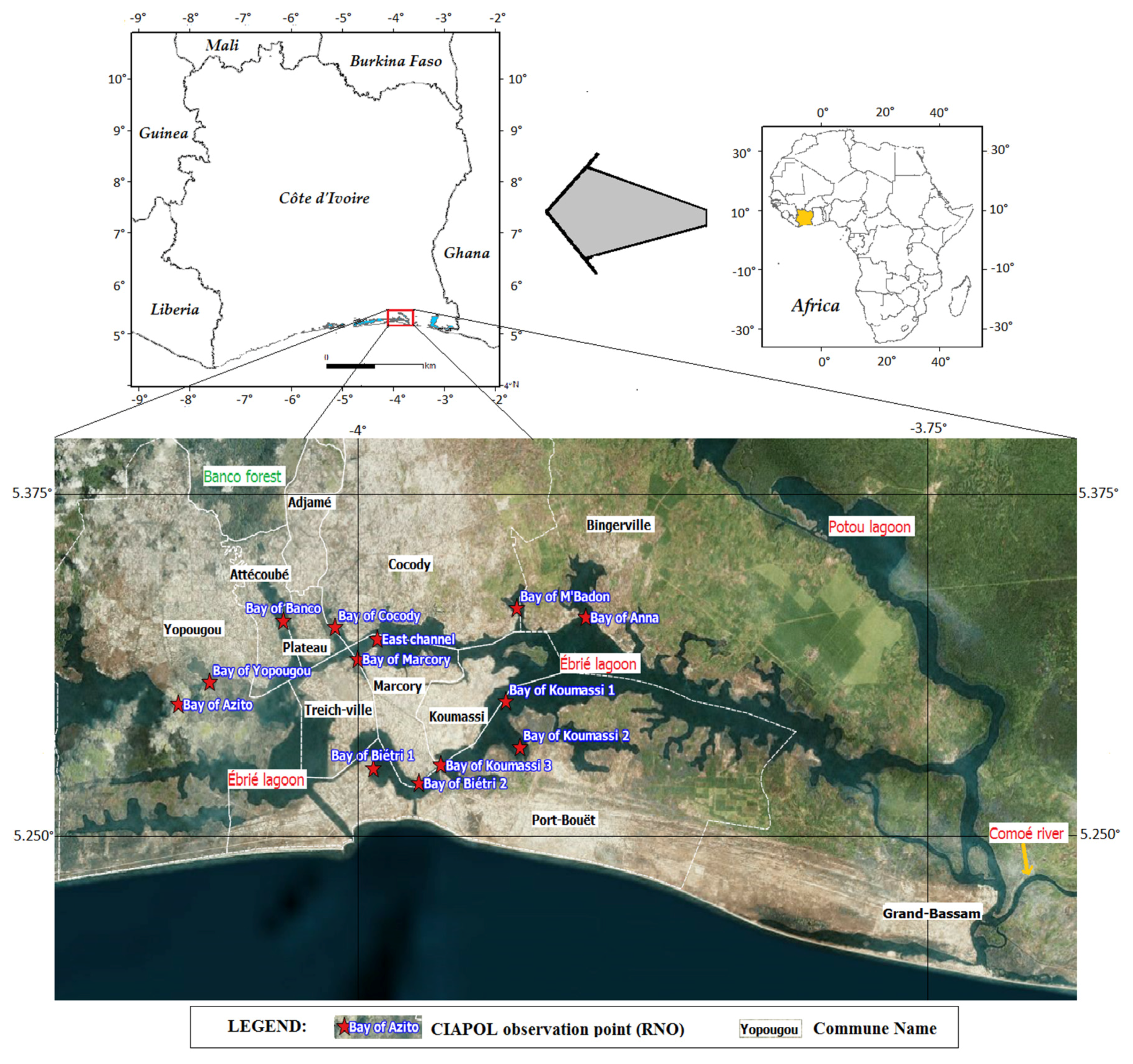
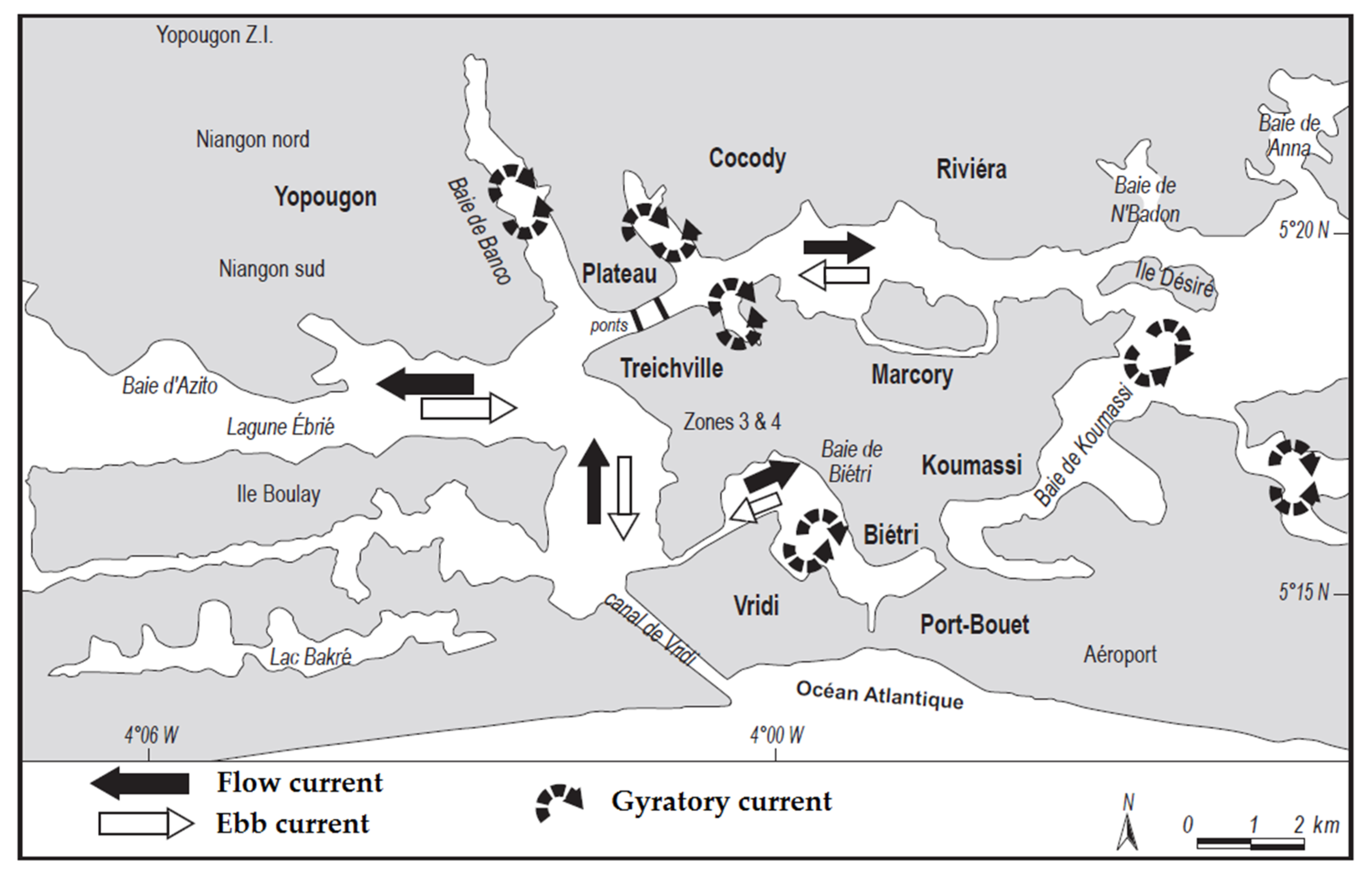
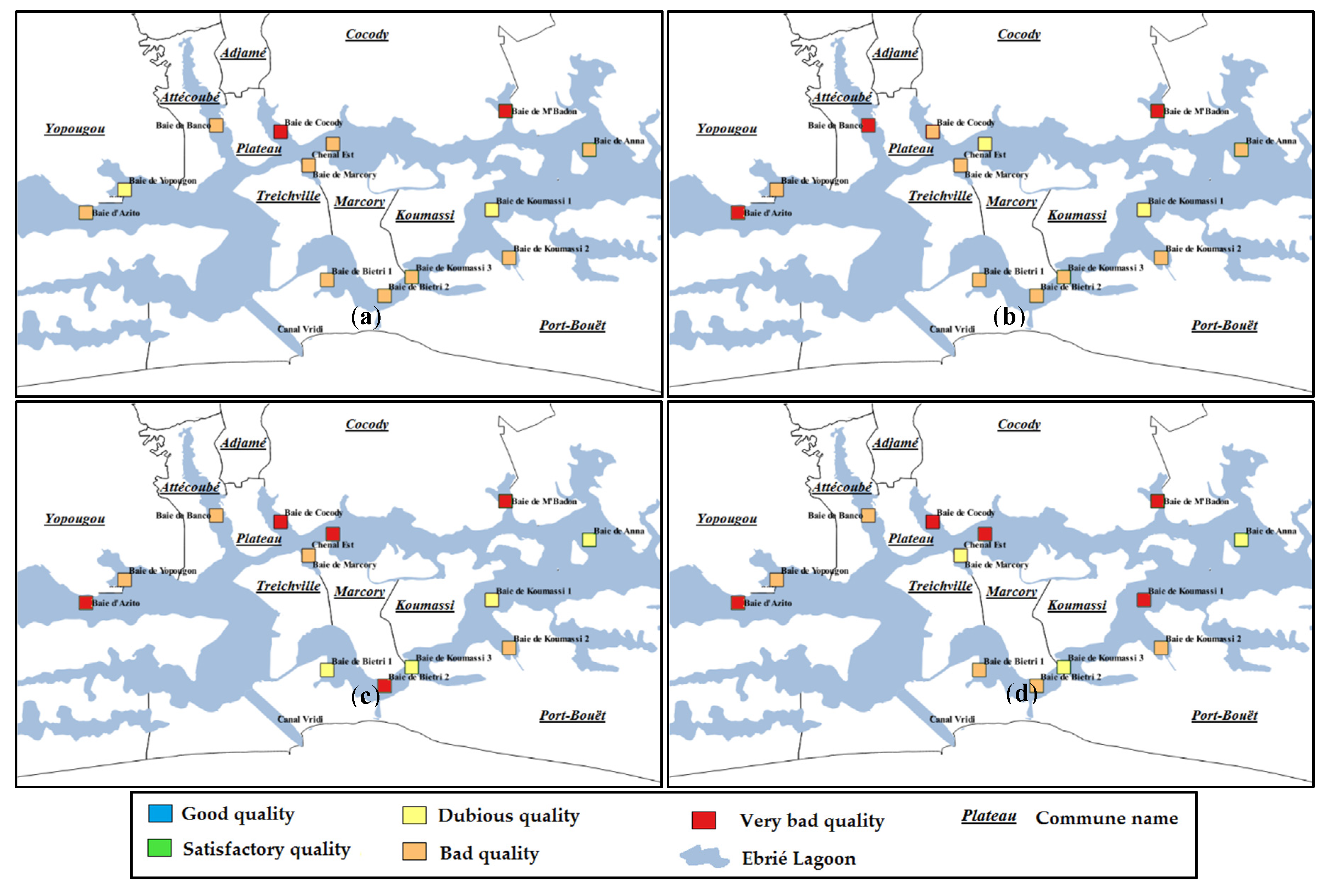
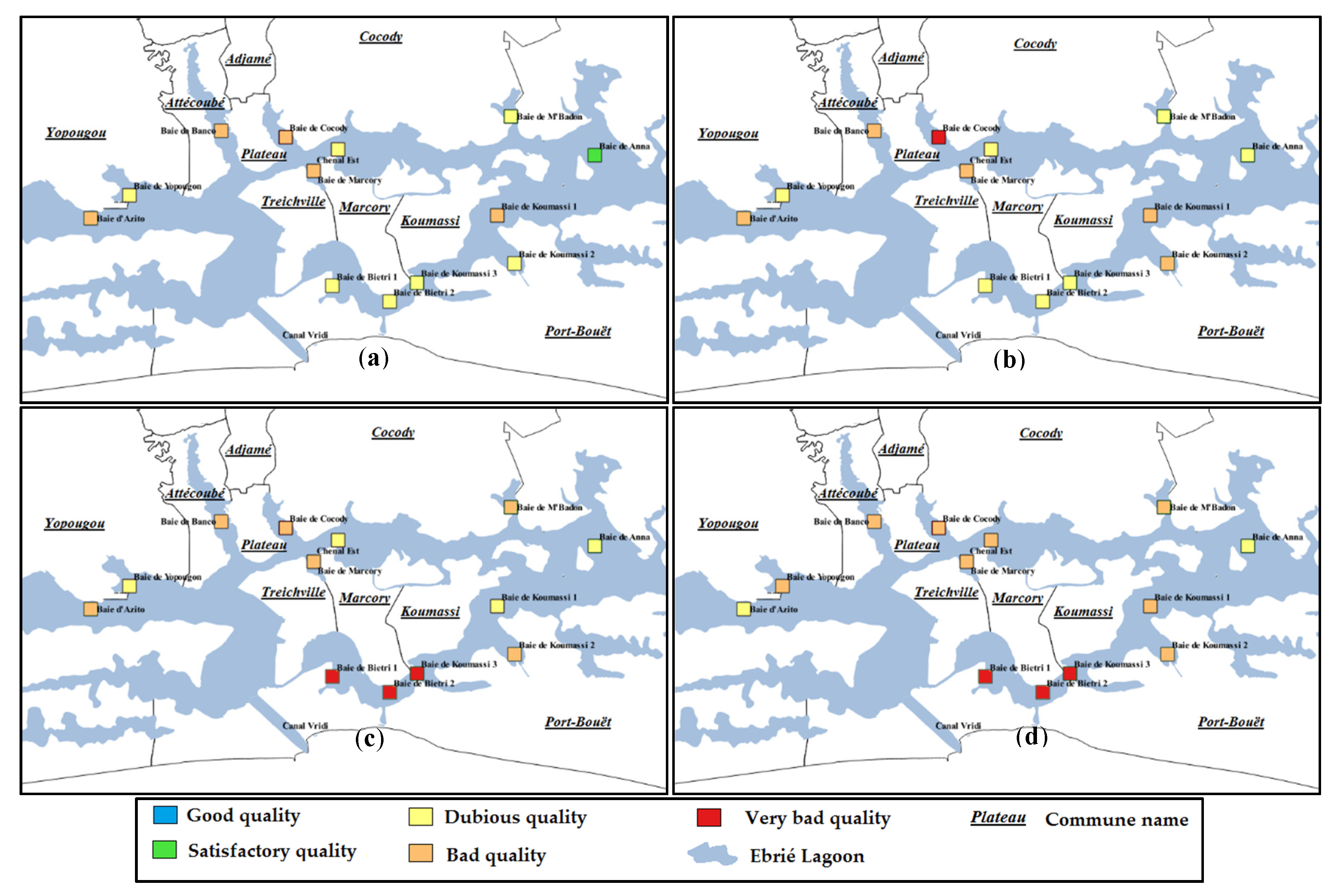
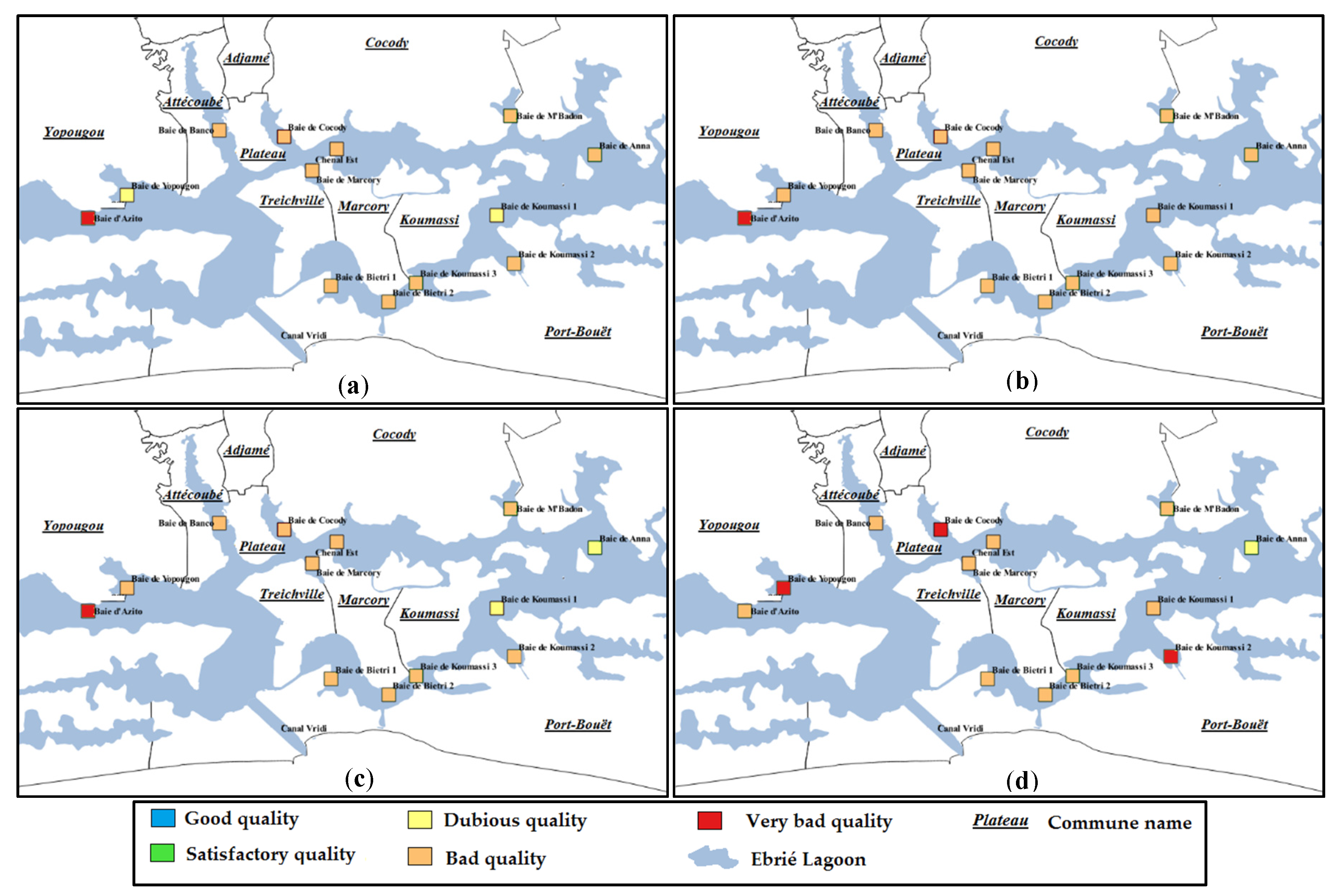
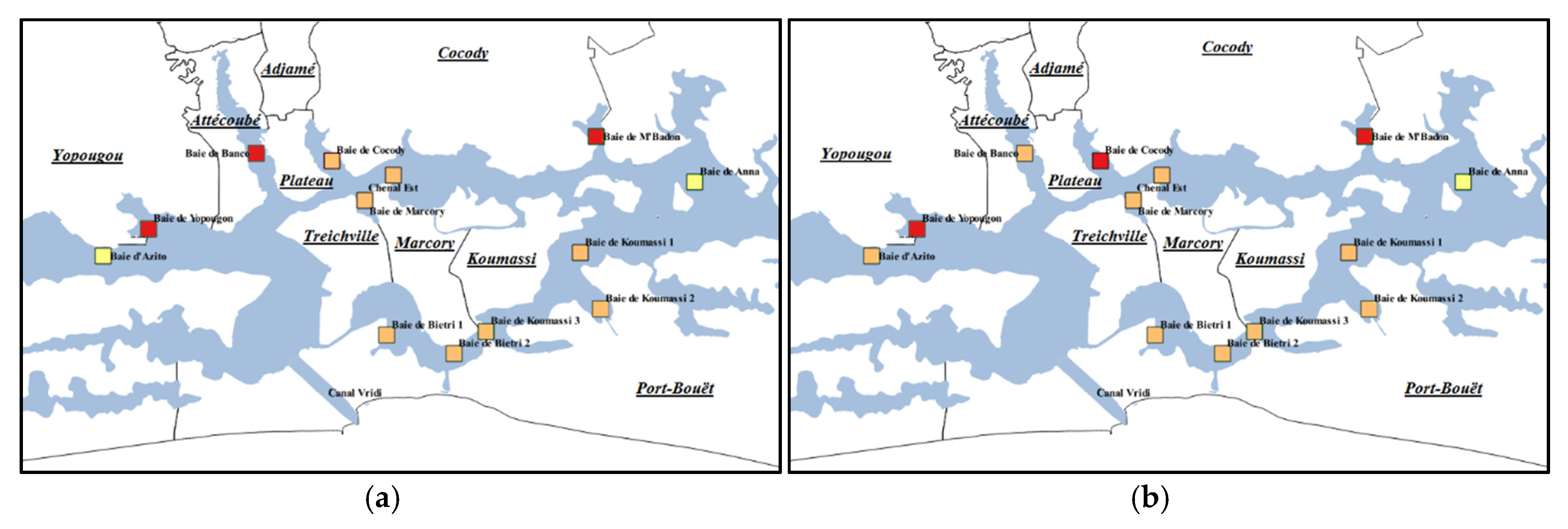
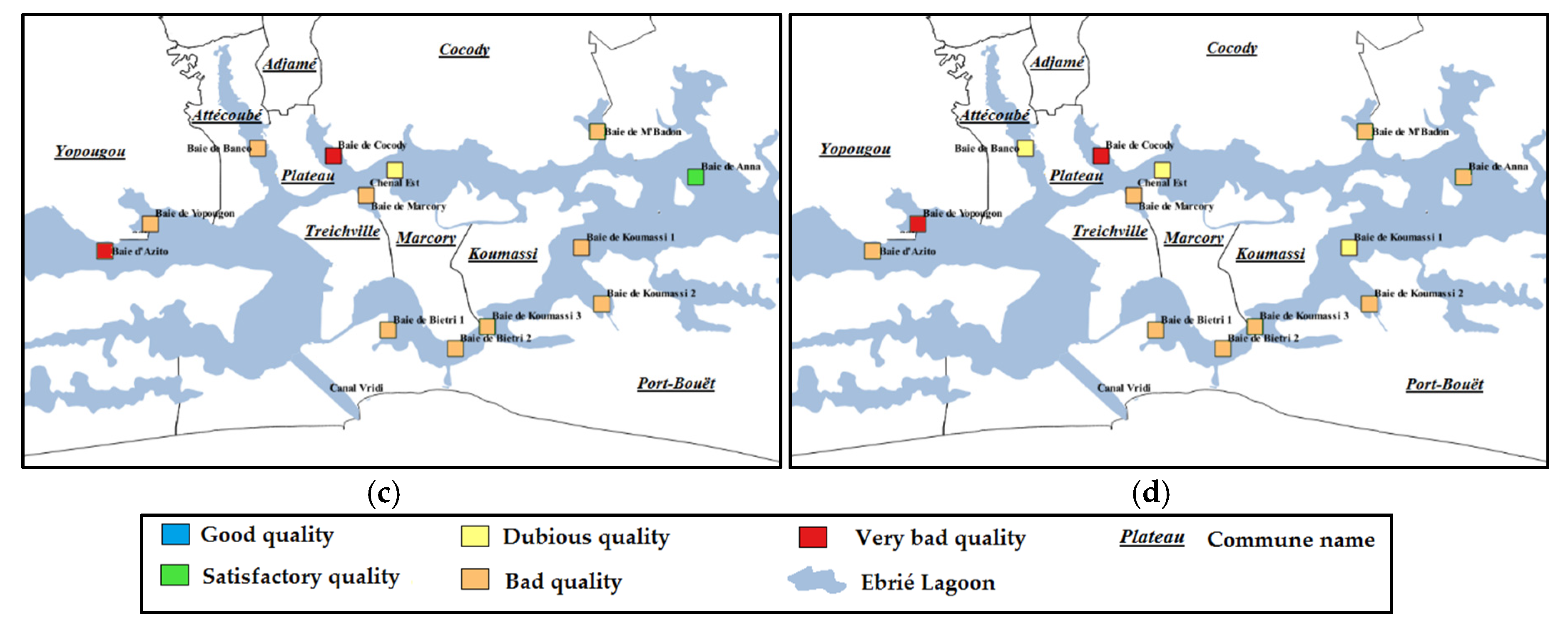
| Usages | Parameters |
|---|---|
| Sports and recreation | Total suspended solids (TSS), Total Coliform (C.Total), Enterococci, Thermotolerant Coliforms (C.Thermo), SECCHI Transparency (Secchi) |
| Irrigation | Total Coliform (C.Total), Thermotolerant Coliforms (C.Thermo), Lead (Pb), Copper (Cu), Nickel (Ni), Total Chrome (Cr), Arsenic (As), Cadmium (Cd), Zinc (Zn), Chlorides (Cl), Selenium (Se) |
| Livestock watering | NO2(−), Nitrates (N), Sodium (Na), Calcium (Ca), Sulfate (SO4(2−)), Free cyanide, Zinc (Zn), Copper (Cu), Selenium, Arsenic (As), Mercury (Hg), Lead (Pb), Nickel, Cadmium(Cd), Total Chrome (Cr) |
| Aquaculture | Chlorophyll a + pheopigments (Chlorophyll), NO2−, Free Cyanides (CN−), Mercury (Hg), NH4(+), Phosphor (P), Oxygen (O), Calcium (Ca), Copper (Cu), Zinc (Zn), Nitrates (N), TSS, pH, BOD5, Mercury (Hg), Lead (Pb), Nickel (Ni), Cadmium (Cd), Total Chrome (Cr) |
| Aptitude Class | Color | Description |
|---|---|---|
| 80 (80–100) | Blue | Good quality |
| 60 (60–80) | Green | Satisfactory quality |
| 40 (40–60) | Yellow | Dubious quality |
| 20 (20–40) | Orange | Bad quality |
| 0 (0–20) | Red | Very bad quality |
| Intensity of Importance | Definition |
|---|---|
| 1 | Equal importance |
| 3 | Moderate importance |
| 5 | Strong importance |
| 7 | Very strong importance |
| 9 | Extreme importance |
| 2, 4, 6, 8 | Intermediate values between two judgments, used to refine the judgment |
| Aquaculture | Sport and Recreation | Irrigation | Livestock Watering | ||||
|---|---|---|---|---|---|---|---|
| Parameter | Weight | Parameter | Weight | Parameter | Weight | Parameter | Weight |
| Cd | 0.16 | TSS | 0.33 | As | 0.135 | As | 0.16 |
| Pb | 0.13 | Secchi | 0.23 | Pb | 0.2 | Pb | 0.2 |
| Zn | 0.15 | C.Total | 0.19 | Cd | 0.2 | Cd | 0.17 |
| O | 0.08 | C.Thermo | 0.11 | Zn | 0.21 | Zn | 0.2 |
| P | 0.05 | Enterococci | 0.14 | Cr | 0.18 | N | 0.04 |
| pH | 0.035 | Sum | 1 | C.Total | 0.041 | NO2(−) | 0.08 |
| Cr | 0.13 | C.Thermo | 0.034 | Cr | 0.15 | ||
| TSS | 0.03 | Sum | 1 | Sum | 1 | ||
| N | 0.07 | ||||||
| NO2(−) | 0.08 | ||||||
| NH4(+) | 0.085 | ||||||
| Sum | 1 | ||||||
© 2018 by the authors. Licensee MDPI, Basel, Switzerland. This article is an open access article distributed under the terms and conditions of the Creative Commons Attribution (CC BY) license (http://creativecommons.org/licenses/by/4.0/).
Share and Cite
Naga, C.; Talnan Jean Honoré, C.; Delfin, O.A.; Bernard, Y.O.; Guillaume, Z.S.; Henoc Sosthène, A.; Mpakama, Z.; Issiaka, S. Spatio-Temporal Analysis and Water Quality Indices (WQI): Case of the Ébrié Lagoon, Abidjan, Côte d’Ivoire. Hydrology 2018, 5, 32. https://doi.org/10.3390/hydrology5030032
Naga C, Talnan Jean Honoré C, Delfin OA, Bernard YO, Guillaume ZS, Henoc Sosthène A, Mpakama Z, Issiaka S. Spatio-Temporal Analysis and Water Quality Indices (WQI): Case of the Ébrié Lagoon, Abidjan, Côte d’Ivoire. Hydrology. 2018; 5(3):32. https://doi.org/10.3390/hydrology5030032
Chicago/Turabian StyleNaga, Coulibaly, Coulibaly Talnan Jean Honoré, Ochou Abé Delfin, Yapo Ossey Bernard, Zabi Soko Guillaume, Aclohou Henoc Sosthène, Ziyanda Mpakama, and Savané Issiaka. 2018. "Spatio-Temporal Analysis and Water Quality Indices (WQI): Case of the Ébrié Lagoon, Abidjan, Côte d’Ivoire" Hydrology 5, no. 3: 32. https://doi.org/10.3390/hydrology5030032
APA StyleNaga, C., Talnan Jean Honoré, C., Delfin, O. A., Bernard, Y. O., Guillaume, Z. S., Henoc Sosthène, A., Mpakama, Z., & Issiaka, S. (2018). Spatio-Temporal Analysis and Water Quality Indices (WQI): Case of the Ébrié Lagoon, Abidjan, Côte d’Ivoire. Hydrology, 5(3), 32. https://doi.org/10.3390/hydrology5030032




